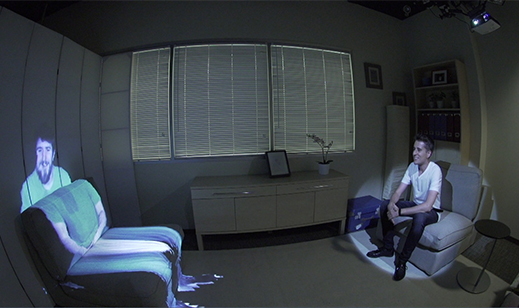Despite almost every new digital device (phones, tablets, laptops) shipping with cameras, the number of times you video call someone is still tiny in 2016. Part of the reason is that you can call from locations, like home, where you don’t have your game face on.
Another common reason is the failing to deliver an experience that’s equal to sitting across the room from the person. In theory, Skype, Facetime, Hangouts and Facebook, should all have fundamentally changed how we move about the world. In reality, there’s more flights today than there ever has been, which means people still remain unsatisfied with the digital experience, so much so they’re prepared to endure the cost, the time and the inconvience of flying.
Every airline flight in the world over a 24-hour period pic.twitter.com/HnJJKCeF3q
— Vala Afshar (@ValaAfshar) January 18, 2016
A new project from Microsoft Research division called RoomAlive is trying to change all that. The experience takes a projector at each end, adds a Kinect sensor to scan the room (and people) and then project them into the room on the other side of the call.
The goal here is to keep everything at eye level, so if you’re sitting, they’re sitting and not have you abnormally looking upwards to a wall-mounted display.


RoomAlive is a proof-of-concept prototype that transforms any room into an immersive, augmented entertainment experience. Our system enables new interactive projection mapping experiences that dynamically adapts content to any room. Users can touch, shoot, stomp, dodge and steer projected content that seamlessly co-exists with their existing physical environment. The basic building blocks of RoomAlive are projector-depth camera units, which can be combined through a scalable, distributed framework. The projector-depth camera units are individually autocalibrating, self-localizing, and create a unified model of the room with no user intervention. We investigate the design space of gaming experiences that are possible with RoomAlive and explore methods for dynamically mapping content based on room layout and user position. Finally we showcase four experience prototypes that demonstrate the novel interactive experiences that are possible with RoomAlive and discuss the design challenges of adapting any game to any room
It looks completely crazy because its new, and well, because its crazy. This feels like a bridge to what we’ll really end up getting and that’s the full augmented reality of a 3 dimensional person that appears in the same room. Given Microsoft’s augmented reality headset, HoloLens, is still years away from consumer release, this is what we get in 2016.
I like the concept, but I do fear that like many of the great innovations that come out of the amazingly well funded Microsoft Research, that this won’t see the light of day in terms of a commercial release.
More information at Microsoft Research via The Next Web and MIT.

